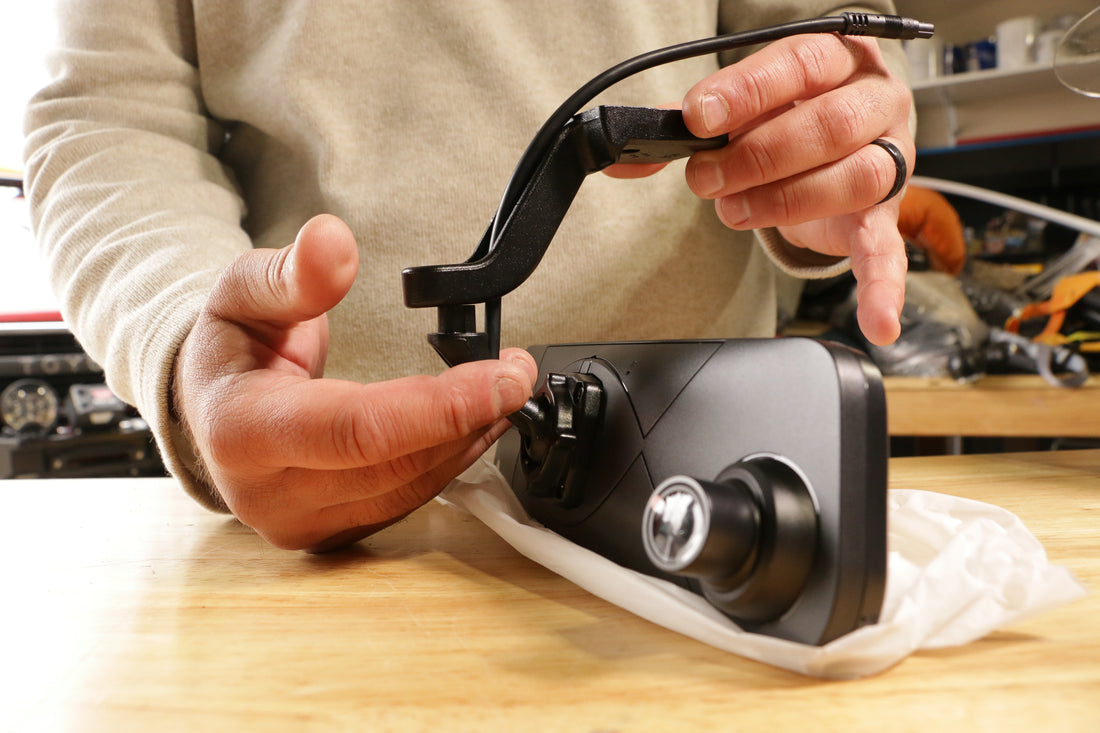
Install Instructions: Toyota 80 Series - LucentVue Smart Rear View Mirror
Share
The LucentVue Smart Mirror is a rear view mirror, dash cam, security cam, nighttime visibility aide, high-definition camera system from Caballo Automotive. Using our 1991 Toyota Land Cruiser, we worked with Caballo to adapt the universal system to be a bolt-in application for an 80 Series Land Cruiser, utilizing the OE mounting hardware and retaining the OE plastic trim, and then included some additional small parts so that you can install and use it right away.
|
Included Parts:
|
Equipment Needed:
|
Installation Steps:
1. Disconnect the battery.
2. Remove the old rear view mirror by sliding the factory plastic trim from the OE rear view mirror mount and remove the two retaining screws holding the mirror in place. Keep the original mounting screws for Step 4.
3. Prepare the new LucentVue mirror:
a. Remove the mounting arm from the ball plate via the one screw.


b. Thread the wire from the back of the mirror through the ball joint from underneath the plate, and attach the ball plate to the back of the mirror with the four (4) included screws.


c. Thread the wire through the hole on the ball joint arm.

d. Thread the wire through the hole on the mounting arm, and reattach the arm to the ball plate.



e. Insert the supplied 32 GB SD card into the slot on the top of the mirror until it clicks in. The unit can accept up to a 128 GB card.

4. Mount the new mirror into place using the original hardware from the removal of the old mirror and reattach the plastic trim. Remove the protective film from the camera lens.


5. Remove the driver side door sill plastic and the lower kick panel to give access to the back of the fuse block. Note: During this step we found that we were missing the plastic trim fasteners on our 80 Series. And for that reason, we’ve included three (3) extra fasteners in case you come across the same situation.
6. Connect power using the supplied posi-tap connectors for switched and constant power behind the fuse block. Note: We used our repair manual to identify the circuits and confirmed with our power probe, choosing the #1 CIG 15 amp for constant power and the #6 WIPER 20 amp for switched power.


a. On the main wiring harness, cut off the original fuse taps and strip both the red and yellow wire about ½”.


b. Attach a posi-tap behind the fuse block to the #1 fuse wire and another to the #6 fuse wire.



c. Insert the stripped yellow wire from the wiring harness into the #1 posi-tap and the red wire into the #6 posi-tap position and screw in both tops of posi-taps.



d. Place the fuse block back into the kick panel.

7. Ground the mirror. Note: Behind the kick panel is a support bracket that we chose to secure the power supply and use for grounding.

a. Remove the support bracket and reattach with the ground wire secured via the screw.

b. Gather the power supply and extra wire and secure to the bracket using zip-ties.

8. Connect the wire harness to the mirror.
a. Paying attention to the notches, attach both the female and male ends to the mirror wires.




b. Using a method of your choice, secure the wires above the windshield along the headliner. We used some clips to hold it up and under the headliner.


9. Run the wiring under the carpet along the front and rear driver door sills, along to the back where the OE jack is stored against the rear quarter panel. Removing the interior panel will be needed for access.



10. Optional: Cut and discard the red wire. This wire is for back-up assist guide lines, and isn’t recommended for this application.

Rear Camera Mounting to the License Plate Lighting Unit or behind License Plate:
11. Run the wire down and through the same grommet that runs the license plate wires in the OE jack location.


a. From underneath the vehicle, follow the license plate lighting wires to the next grommet at the vehicle rear, and loosen that grommet towards you.
12. With the tailgate down, remove the tailgate cover (Snail Armor Tailgate panel in our case) and then the access panel for the license plate light.


13. Carefully pull the accordion grommet from the body at the back of the open tailgate.

14. Run the provided extension wire harness:
a. Place the male end of the harness through the hole behind the removed accordion grommet and then push through the previously loosen grommet (Step 11a) underneath. Note: Our grommet is split on our 80 and this made this step easier.

b. Connect that male end to the main wiring harness underneath the vehicle. Position this connection in/behind the grommet while replacing the grommet.

c. Back up top, run the female end of the extension harness through the accordion grommet enough to grab from inside the open lighting access panel in the tailgate.


d. Pull up the female end of the extension harness into the access panel. Be sure to leave enough slack at the tailgate joint. Replace the accordion grommet.
15. Remove the license plate lighting unit.
a. From the center of the open access panel, pinch and push through the retaining portion of the lighting connector as shown in the photo.

b. Gently unclip the light connector underneath.

c. Using a 10mm socket, remove the three nuts inside the open access panel that secure the license plate lighting unit to the tailgate.

d. Pull out the lighting unit and gently remove the wiring grommet from the tailgate with it.

e. Remove one of the lightbulb covers.

f. Go to Step 16 to mount the rear camera using the LucentVue License Plate Mount or Step 17 to mount the camera to the removed lighting unit.
16. Mounting rear camera behind the license plate:


a. Remove your license plate and place the LucentVue License Plate Mounting Bracket with your attached rear camera behind the license plate and reattach your plate.
b. Adjust camera side screws for best camera angle. This can be adjusted again after reconnecting power to make it easier to determine angle.
c. Go to Step 18 and disregard the camera mounted to the lighting unit in the provided photos. The camera wire will be run through the lighting unit just the same.
17. Mounting rear camera to the license plate lighting unit. Note: Drilling required.
a. Align your rear camera at the middle of the underside of the lighting unit and mark where to drill. Make sure your camera will be facing out the correct way!

b. Drill holes using a 5/64th drill bit.


c. Place the provided double-sided adhesive to the bottom of the rear camera hinge.

d. Clean the mounting location on the lighting unit.
e. Realign the camera hinge with the holes you drilled and adhere the camera. Screw into place using the provided screws.

f. Adjust camera side screws for best camera angle. This can be adjusted again after reconnecting power to make it easier to determine angle.

18. Run the rear camera wire through the lighting unit:
a. Run the wire past through the exposed lightbulb plate.

b. Reattach the lightbulb cover.

c. Run the wire through the same small grommet on the unit as the lighting wires. Heating a cold grommet a bit can help make the grommet more pliable and assist getting the wire gently through.


19. Reattach the license plate lighting unit to the tailgate:
a. Place the lighting wire grommet back into the tailgate.

b. Re-secure the lighting unit to the tailgate with the three nuts that you removed.

c. Reconnect the lighting connector and pop the retaining portion back up through the body.

d. Connect the rear camera wire to the female end of the extension harness inside the access panel.

e. Gather and secure the extra extension wire with a zip tie to ensure it won’t interfere with the latch mechanism.
f. Remove protective film from the rear camera lens.
20. Before replacing all panels you opened, reconnect your battery and turn on the vehicle to check the operation of your new mirror and camera system.
21. With everything in working order*, reinstall your panels and trim throughout. Your installation is complete!
22. Use the provided LucentVue instructions to help with setting up your cameras and recording preferences.
*Never hesitate to give us a call if you have questions!
